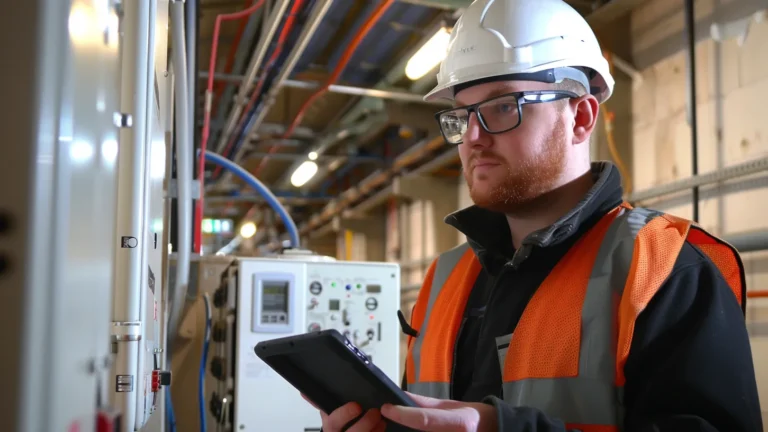SaaS is the abbreviation for “Software as a Service”. SaaS is a model for the provision of software in which applications are provided via the Internet and do not have to be installed locally. SaaS can be used for a variety of applications – including building cleaning software and facility management software. SaaS providers host the software and make it available via the Internet. Customers usually pay a monthly or annual fee to access the software. SaaS offers a number of advantages over traditional licensing and installation of software, including reduced IT costs, easier maintenance and updating, flexibility and scalability. As our own software Wowflow is also a Saas, we would like to explain to you in more detail today what is behind “Software as a Service”.
SaaS in the facility management sector
Facility Management Software (FMS) is a form of SaaS that focuses on the maintenance of buildings and facilities. Whether it’s a small office building or a large industrial complex: FMS helps facility management teams and their supervisors in both cases to plan and carry out building cleaning, maintenance and servicing.
Facility management is a critical component of a company’s overall operating costs. SaaS solutions such as facility management software help to reduce costs and increase efficiency. As FMS is web-based and generally tied to a monthly usage fee, the facility manager is flexible. In addition, the software should always be up to date with the latest technology – regular updates are installed automatically.
Most FMS solutions also offer a mobile app so that facility managers can access important functions on the move.

The advantages of SaaS
SaaS is a software license model in which the software product is not installed and executed on a local computer or server, but is made available via the Internet. SaaS services are often also referred to as “on-demand software” or “cloud software”. The SaaS industry has recorded enormous growth rates in recent years as more and more companies recognize the advantages of this model. SaaS offers a number of advantages over conventional licensing and installation of software.
The most important advantages include:
- Flexibility: SaaS services can usually be rented and can therefore be terminated on a monthly basis. This offers companies a high degree of flexibility, as they are not tied to long-term contracts and can adapt the services to their needs at any time.
- Cost savings: SaaS services eliminate the need for expensive hardware investments and human resources to install and maintain the software. As SaaS providers provide and manage the software, these costs are eliminated for customers. In addition, SaaS services are usually more cost-efficient than traditional licensing models, as customers only pay for the use of the services instead of paying a high price for the purchased version of the software.
- Access from anywhere: SaaS services can be used via the Internet from any location as long as there is an Internet connection. This offers companies great flexibility, as their employees can access the software at any time and from anywhere. ATTENTION: There is also software such as Wowflow that offers an offline function! The Internet connection is not always 100 percent stable, especially in the area of facility management (for example in basements). It is therefore important that users can also work with the application offline.
- Scalability: SaaS services are usually offered on a pay-as-you-go basis, allowing companies to increase or decrease the use of the software as needed. This makes SaaS ideal for companies that experience seasonal peaks in demand or grow rapidly and need to increase software usage quickly.
- Continuous further development: SaaS products are usually constantly being further developed – i.e. updates are on the agenda. Depending on the provider, it may even be possible to collaborate on these innovations or provide input for new functions. With on-premise solutions, on the other hand, updates or additional packages have to be paid for separately.
The disadvantages of SaaS
SaaS can be a great tool for (facility management and cleaning) companies that are trying to save costs and simplify their operations. However, SaaS also has some disadvantages that should be considered before you decide to use it.
- Cost: One of the disadvantages of SaaS is the fact that it can be more expensive than traditional software. In addition to the monthly fees, SaaS providers sometimes also have to pay for updates and maintenance. However, this is not always the case – so find out in advance!
- Reliability: In addition, SaaS is not always as reliable as conventional software. This is usually due to the fact that SaaS services are dependent on the Internet. This means that if a connection is interrupted or the provider’s server fails, users may no longer be able to access their data. However, as mentioned earlier in the article, many providers in the facility management sector attach great importance to the offline function – as does Wowflow.
- Flexibility: After all, SaaS is often less flexible than conventional software. Many SaaS providers only offer their customers limited options to customize or expand their services. Here, too, it is worth doing in-depth research. For us at Wowflow, the needs and wishes of our customers have top priority! That is why we are in constant communication with them and always develop those features that are particularly in demand.
Overall, SaaS has both advantages and disadvantages. Before you decide on a SaaS provider, you should carefully weigh whether the advantages outweigh the disadvantages.
What should be considered when deciding on SaaS?
As mentioned, SaaS (Software as a Service) is already used in many areas of daily business life. Regardless of whether you use a customer relationship management (CRM) program, facility management software or an enterprise resource planning (ERP) program: Consider the following factors when making your selection.
- The reputation of the SaaS provider: Find out about the SaaS provider and read the reviews of other customers before you decide to subscribe. Especially in the SaaS sector, many providers are start-ups. Does the SaaS already have a broad customer base in your industry? Is it well financed? These factors should not be underestimated.
- The features and functions of the SaaS: Think about what type of SaaS you need and make sure the provider offers the features and functions you are looking for.
- Pricing for SaaS: SaaS providers usually charge a monthly or annual subscription fee. Compare the prices of different providers before making a decision.
- The terms of the SaaS agreement: Read and understand the terms of the SaaS agreement before you decide to subscribe. Make sure you are aware of any early repayment penalties or other conditions that may apply.
Considering these factors is guaranteed to help you find the right SaaS provider for your business needs.
So, now we’ve explained what SaaS is and what advantages it offers. We have also shown how SaaS works and what disadvantages could arise. For many companies, SaaS is the ideal solution when it comes to implementing facility management or building cleaning software.
Test our software free of charge and see the benefits of such a solution for yourself.



